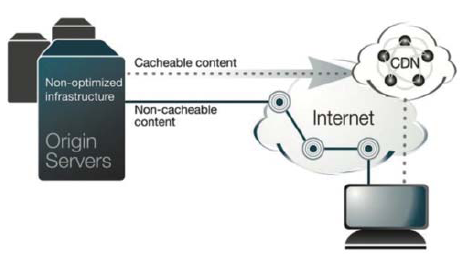A Three-Legged Race to Faster Websites

CDNs + FEO + OCA = Web Performance Optimization (WPO)
Today's Internet offers a wealth of dynamic content - customized ads, streaming and on-demand videos, product recommendations, news articles and more - that enhances the user's online experience. Website visitors expect great website design, but they also want fast load times. A slow website will negatively impact the customer experience, search engine results and, ultimately, sales or readership.
Content delivery networks (CDNs), front-end optimization (FEO) and origin content acceleration (OCA) are new technologies for optimizing performance. Separately, these tools offer a partial fix but can't provide the complete answer for the increasingly complex dynamic content being used on websites.
Think of these tools as three legs on the Web performance optimization (WPO) stool, which, when combined, can deliver faster performance - especially for dynamic interactive advertising and Web video content.
AN OVERVIEW OF WPO
WPO evolved as webmasters looked for ways to address the growing demand for high-quality, downloadable and streaming rich media. But WPO technology really took off with the advent of Web 2.0, which changed the nature of the problem.
Web 2.0 technologies encourage user interactivity and personalization, changing the nature of Web traffic. The formerly synchronous transfer of static content from server to browser has yielded to traffic composed of an increasing bi-directional mix of static and dynamic content, served up independently to customize user Web experiences and allow website operators to tailor ads and content to specific user interests.
As consumers and companies come to depend more and more on the Web to deliver information and services, the use of WPO techniques to reduce page-load times is becoming essential. While consumer patience thresholds for load times will vary by industry, online retailers can be sure that any significant delay will be detrimental to the amount or quality of page views, revenues and search engine rankings.
THE DIFFERENT APPROACHES
Content Delivery Networks CDNs have become very popular among website owners who have media-rich sites with Web objects (text, graphics, URLs and scripts), downloadable objects (media files, software and documents), applications (ecommerce, portals), on-demand and live-streaming media, and social networks.
A CDN is a system of servers located close to endusers, which contain cached copies of original data or content. When users request content, the request is routed to the server closest to them, shortening the distance the content has to travel and improving download speed by reducing latency.
Once a service for sophisticated websites, the CDN market has become commoditized with the explosion of small business ecommerce sites and blogs - making affordable CDN services widely available for small websites and blogs as well as large ones. Any website owner can easily sign up for a low-cost CDN by doing some comparison research on costs and options and then signing up online.
Most services integrate easily with websites, are up and running quickly and provide customer service to help with any problems. CDNs can be purchased on a monthly basis or through a pay-as-you-go model.
Front-end Optimization
While CDNs help to address part of the slow website problem by reducing network latency, not all content can be stored in a CDN. Front-end optimization software helps speed up the transport of origin content over the network by automatically streamlining Web page HTML code and the number of page resources required to download a given page, as well as making the browser process the page faster.
A popular FEO tool called mod_pagespeed (https://wsm.co/KGGzqK) has been made available by Google. Mod_pagespeed is an open-source tool for Apache servers that can significantly reduce page-load times. Other FEO site optimizers are available from various vendors, as appliances that can be installed in the data center of a large website or as a service via the cloud for smaller sites.
Origin Content Acceleration
CDNs and FEO help speed up websites by delivering cached content faster and speeding up the user's browser process, but neither of these methods can solve network latency problems inherent in dynamic content coming from origin servers.
The main performance problem involved in serving content from origin is caused by inefficiency in the primary Internet transport protocol (TCP, for transmission control protocol), which was not designed for Web 2.0 content. TCP focuses on data transport reliability and redundancy, not speed, low latency and the media-rich data present in Web 2.0.
Because of this, these protocols break down over long distances, and in congested environments requiring repeated retransmission of packets, result in low effective throughput - especially impacting data delivered from origin servers. Moreover, these protocols perform exponentially worse as distance and congestion increase, leading to even greater end-user dissatisfaction.
Origin content acceleration solves the issue of distancerelated network latency by accelerating origin-served content from the server to the end-user using algorithms to fix inefficient network protocols in order to reduce the transport latency between the origin server and the user. OCA accelerates all content - dynamic and static - all the way to the end-user's computer or mobile device.
In fact, the greater the distance, the greater the benefit that OCA provides, resulting in fast-performing websites both in the U.S. and in other countries such as China, India and South America, where congestion is high and where the transport distance can be very long. OCA is available as a combination of software modules and appliances that can be installed on the server side, with no browser plug-in or software clients needed at the receiving end.
HOW IT WORKS
On today's websites that have both dynamic, origin-served content and static files that can be cached, it is often the origin-served content that must come first before calls are made for images, style sheets and other cached elements. The figure shown illustrates the typical path of Web data to a user's computer, with cacheable content being served from regional CDN servers and non-cacheable content being delivered from an origin server. 
In many cases, the origin-served content is the gating factor on webpage performance because the whole page must wait on the origin-served content. Webpage load time, then, is more critical than ever in order to ensure a satisfactory end-user experience.
A complete approach that leverages all three of the WPO approaches mentioned in this article should be considered to achieve the goal of delivering a webpage in less than two seconds, regardless of distance from the enduser. Current solutions that include CDN (moving the content closer to the end-user) and FEO (content optimization) offer benefits that, when integrated with OCA (origin content acceleration), provide the best possible advantages for fast websites.
About the Author: Jerry Hall is vice president of marketing at FastSoft, a company whose products aim to increase website and Web application performance and speed the distribution of video and other digital content across the Internet.

Subscribe to Our Newsletter!
Latest in Marketing








